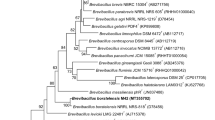Abstract
A comparative study on the basic structural characteristics of exopolysaccharide (EPS) and capsular polysaccharide (CPS) produced by the Southern Ocean (Indian Sector) origin Pseudoalteromonas sp. MB-16 has been conducted. It has a higher production rate of EPS as compared to that of CPS and the maximum production rate is 0.7 g/l when glucose is the carbon source. Elemental analysis and infrared spectroscopic study have given a brief compositional insight on the EPS and CPS produced by the marine bacterium, whereas scanning electron micrographs have revealed the morphological structure of Pseudoalteromonas sp. derived EPS and CPS. Both the polysaccharides show significant thermal stability as confirmed by thermogravimetric analysis. In all the experiments, Pseudoalteromonas sp. derived EPS and CPS have given similar results when compared to standard bacterial polysaccharides dextran and guar gum. This present study gave an important preliminary idea about the nature of bacterial polysaccharides produced by the Southern Ocean (Indian Sector) origin microbe.






Similar content being viewed by others
References
Rehm BHA (2010) Bacterial polymers: biosynthesis, modifications and applications. Nat Rev Microbiol 8:578–592. https://doi.org/10.1038/nrmicro2354
Donlan RM, Costerton JW (2002) Biofilms: survival mechanisms of clinically relevant microorganisms. Clin Microbiol Rev 15(2):167–193. https://doi.org/10.1128/CMR
Paul F, Morin A, Monsan P (1986) Microbial polysaccharides with actual potential industrial applications. Biotechnol Adv 4:245–259. https://doi.org/10.1016/0734-9750(86)90311-3
Banerjee A, Bandopadhyay R (2016) Use of dextran nanoparticle: a paradigm shift in bacterial exopolysaccharide based biomedical applications. Int J Biol Macromol 87:295–301. https://doi.org/10.1016/j.ijbiomac.2016.02.059
Jones AT, Dovle M (1996) Improving the efficiency of matrix acidizing with a Succinoglycan Viscosifier. SPE Prod Facil 11:144–149
Lau HC (1994) Laboratory development and field testing of succinoglycan as a fluid-loss-control fluid. SPE Drill Complet 9:221–226
Halder U, Banerjee A, Bandopadhyay R (2017) Structural and functional properties, biosynthesis and patenting trends of bacterial succinoglycan: a review. Indian J Microbiol. https://doi.org/10.1007/s12088-017-0655-3
Ochoa GF, Santos VE, Gasas JA, Goemz E (2000) Xanthan gum: production, recovery, and properties. Biotechnol Adv 18:549–579. https://doi.org/10.1016/S0734-9750(00)00050-1
Sathiyanarayanan G, Dineshkumar K, Yang YH (2017) Microbial exopolysaccharide-mediated synthesis and stabilization of metal nanoparticles. Crit Rev Microbiol. https://doi.org/10.1080/1040841X.2017.1306689
Banerjee A, Halder U, Bandopadhyay R (2017) Preparations and applications of polysaccharide based green synthesized metal nanoparticles: a state-of-the-art. J Cluster Sci 28:1803–1813. https://doi.org/10.1007/s10876-017-1219-8
Saravanan P, Jayachandran S (2008) Preliminary characterization of exopolysaccharides produced by a marine biofilm-forming bacterium Pseudoalteromonas ruthenica (SBT 033). Lett Appl Microbiol 46:1–6. https://doi.org/10.1111/j.1472-765X.2007.02215.x
Roca C, Lehmann M, Torres CA, Baptista S, Gaudêncio SP, Freitas F, Reis MA (2016) Exopolysaccharide production by a marine Pseudoalteromonas sp. strain isolated from Madeira Archipelago ocean sediments. New Biotechnol 33:460–466. https://doi.org/10.1016/j.nbt.2016.02.005
Gupta P, Balaji R, Parani M, Chandra TS, Shukla P, Kumar A, Bandopadhyay R (2015) Phylogenetic analysis and biological characteristic tests of marine bacteria isolated from Southern Ocean (Indian sector) water. Acta Oceanol Sin 34:73–82. https://doi.org/10.1007/s13131-015-0709-5
Ramaiah N, Jain A, Meena RM, Naik RK, Verma R, Bhat M, Mesquita A, Nadkarni A, Ahmed T, Bandekar M, Gomes J (2015) Response of bacteria and phytoplankton from a subtropical front location Southern Ocean to micronutrient amendments ex-situ. Deep Sea Res Part II 118:209–220. https://doi.org/10.1016/j.dsr2.2015.03.013
Reddy KJ, Soper BW, Tang J, Bradley RL (1996) Phenotypic variation in exopolysaccharide production in the marine, aerobic nitrogen-fixing unicellular cyanobacterium Cyanothece sp. World J Microbiol Biotechnol 12:311–318. https://doi.org/10.1007/BF00340206
Gray KR, Biddlestone AJ (1973) Composting-process parameters. Chem Eng 2:71–76
Acknowledgements
The authors are thankful for the Expedition support to MoES, New Delhi and NCAOR, Goa (No. MoES/NCAOR/SOS/1/2007PC-I; dated January 4, 2011) and research support to BIT Mesra, Ranchi. One of the authors gratefully acknowledges the financial support as M. Tech fellowship to Centre of Excellence (COE) (Ref No. NPIU/TEQIP II/FIN/31/158, dated April 16, 2013) at the Department of BioEngineering. Another author is thankful to SRF (State Funded) for the financial assistance [Fc (Sc.)/RS/SF/BOT./2014-15/103 (3)]. Urmi Halder is thankful for the financial assistance to JRF-State Fund [Fc (Sc.) /RS/SF/BOT./2017-18/22)].
Author information
Authors and Affiliations
Corresponding author
Ethics declarations
Conflict of interest
The authors declare that they have no conflict of interest.
Additional information
Significance Statement
First report on bacterial EPS/CPS production from Southern Ocean (Indian Sector). Optimization of EPS/CPS production. Preliminary characterization of both EPS and CPS from Pseudoalteromonas sp. MB-16.
Rights and permissions
About this article
Cite this article
Sengupta, S., Banerjee, A., Halder, U. et al. Comparative Study on Structure of Exopolysaccharide and Capsular Polysaccharide Produced by Southern Ocean Origin Pseudoalteromonas sp. MB-16. Proc. Natl. Acad. Sci., India, Sect. B Biol. Sci. 89, 283–290 (2019). https://doi.org/10.1007/s40011-017-0942-0
Received:
Revised:
Accepted:
Published:
Issue Date:
DOI: https://doi.org/10.1007/s40011-017-0942-0




